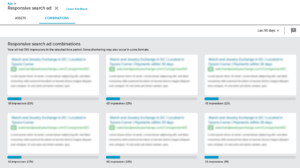Table of Contents
In 2018, Google introduced Responsive Search Ads (RSAs). In addition to Expanded Text Ads, RSAs allow users to write more headlines and descriptions that allow Google to automatically test and show the highest-performing ad variations more often. Unlike Expanded Text Ads, where advertisers keep full control of their ad copy, RSAs require users to give away some control to Google. On October 22th 2019, RSAs became available to all advertisers. If you haven’t used RSAs yet or haven’t updated your ad copy recently, the following tips will help you get the most out of Responsive Search Ads.
Related Content:
1. Use as many (relevant) headlines and descriptions as you can!
Responsive Search Ads allow you to write up to 15 headlines and 4 descriptions. Google will then optimize each ad by showing the headlines and descriptions that are likely to perform the best. Responsive Search Ads will look similar to Expanded Text Ads, with up to 3 headlines and 2 descriptions displayed (ad extensions can also be displayed). The Ad Strength rating provided by Google is a good metric to use when you’re working to improve your RSAs. Always try to get your Ad Strength to “Excellent” by adding more relevant headlines and descriptions.
2. Include your keywords in headlines and descriptions
Like other ads, people expect to see keywords they are searching for. Make sure to include your keywords in both the headline and description of your ad copy. You can use Dynamic Keyword Insertion (DKI) if you want to personalize your ad copy and match the keyword that caused the ad to show.
3. Think about all ad variations (and how they mix together)
It’s always important to make sure that your ad doesn’t create any confusion for your users. For example, avoid having two headlines with contradictory messages (like “35% off our entire website” and “35% off on all shoes”).
You can decide how Google mixes your headlines and descriptions with pins. You can pin any headline in positions 1, 2 or 3 (but keep in mind the 3rd headline won’t always show up). This is a good strategy to use if you want to pin any high-value keywords in the 1st or 2nd position headline. RSAs also allow you to pin descriptions in positions 1 or 2 if you have a specific message you want your potential customers to see.
4. Think about all your Unique Selling Propositions
According to Entrepreneur, a Unique Selling Proposition is: “the factor or consideration presented by a seller as the reason that one product or service is different from and better than that of the competition”. Think about what makes your business or organization different than your competitors and include it in your ad copy. Are your prices lower, your delivery faster, your product customizable? Make sure that your potential customers know that right away.
Also, think about all the call-to-actions on your landing pages and make sure to include all of them in your headlines and descriptions to tell users what to do next after they click on your ads.
5. Monitor results and adjust ad copy as needed
Google recently introduced a tool new feature to see which RSA combinations get the most impressions. You can access it by clicking on View asset details, then Combinations. You can use it to monitor your ads and make sure that the variations make sense to your customers. Another advantage of RSAs is that you can easily add a promotional ad copy or a message you want all your customers to see and pin it so it shows up in every ad variations.
Additionally, whenever you update your landing page, always make sure to look at your headlines and descriptions to verify if they are still relevant to your activities.
6. Don’t forget about Expanded Text Ads
Google’s best practice is to have at least two Expanded Text Ads and one Responsive Search Ad in every ad group. Depending on your campaign objectives or your industry, RSAs may perform better than ETAs. That’s why it’s important to frequently review your ad performance. Look at how your RSAs perform in terms of click-through rate, cost-per-click, and conversion rate compared to ETAs and make changes as necessary.
Have you adopted Responsive Search Ads? How do you use them? Let us know in the comments!
Do you need help creating or managing your Google Ads campaigns? Feel free to reach out and we will be happy to help!
Search News Straight To Your Inbox
*Required
Join thousands of marketers to get the best search news in under 5 minutes. Get resources, tips and more with The Splash newsletter:

